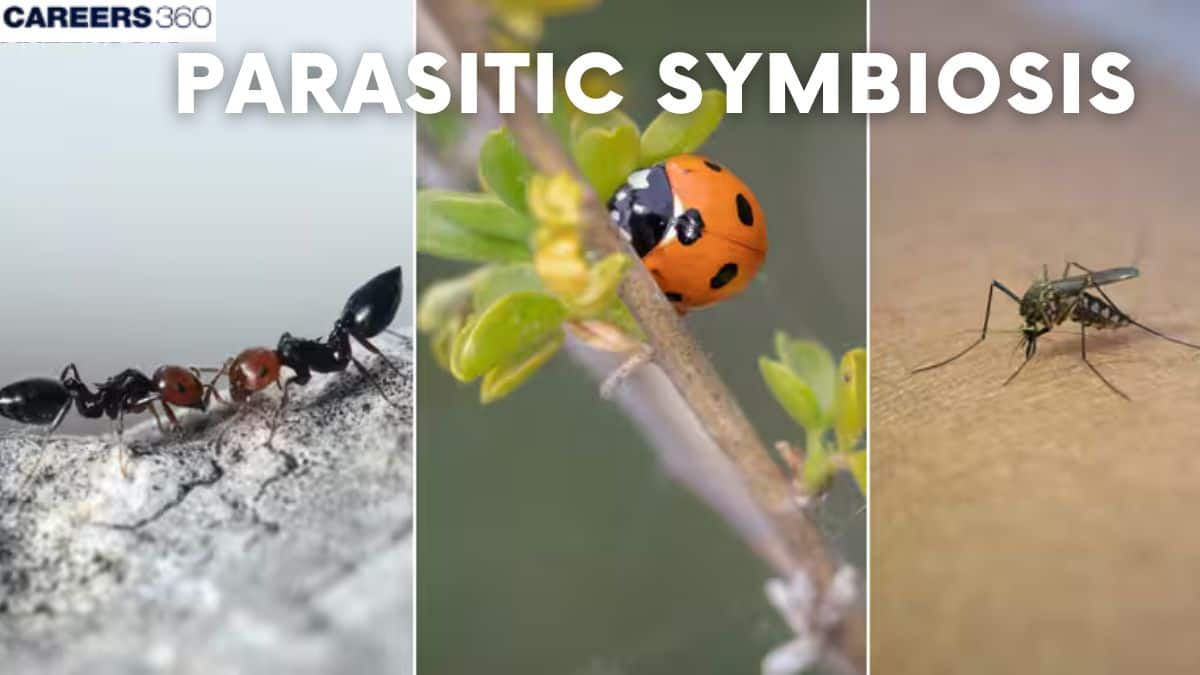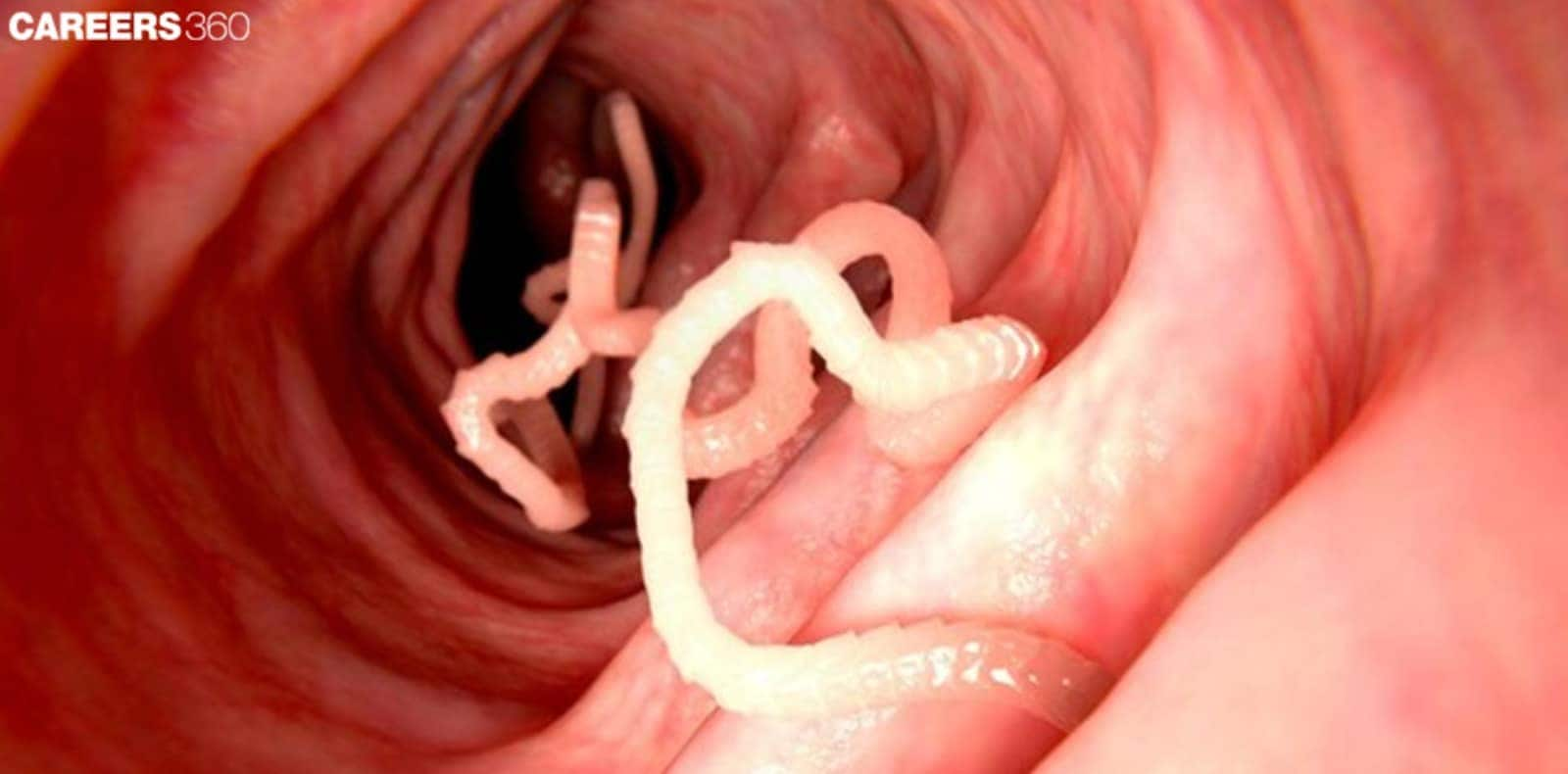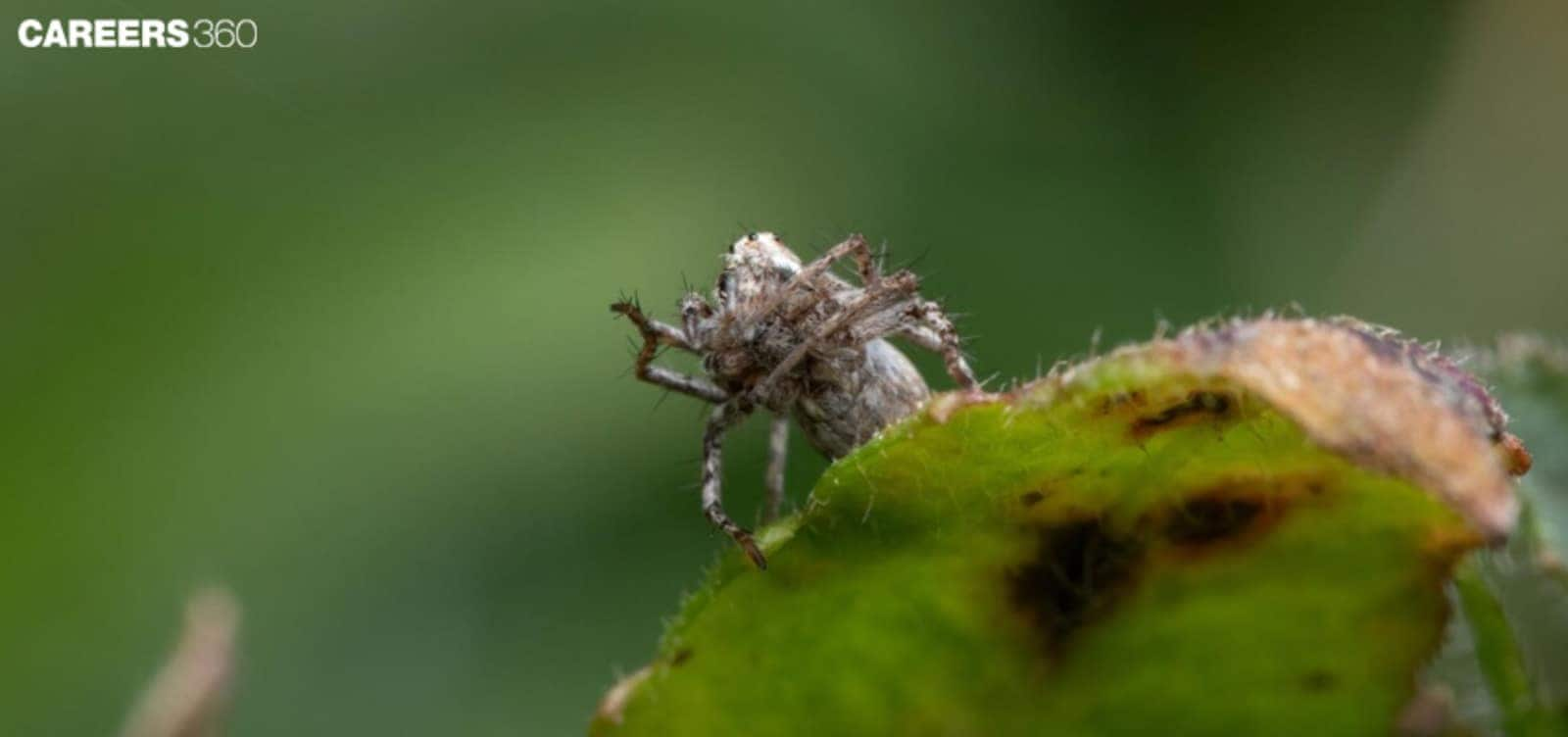Parasitic Symbiosis: Definition, Meaning, Overview, Examples, Types
Parasitic symbiosis is a relationship where one species, the parasite, benefits by living on or inside another species, the host, which is harmed in the process. Found in plants, animals, fungi, and humans, parasitism plays a major role in ecology, disease, and evolution, making it a key NEET and Class 12 Biology topic.
This Story also Contains
- What is Symbiosis?
- What is Parasitic Symbiosis?
- Dependence of Parasite on Host for Nutrients
- Types of Parasitic Symbiosis
- Parasitic Symbiosis In Humans
- Evidence of Symbiosis in Evolution
- Parasitic Symbiosis NEET MCQs (With Answers & Explanations)

What is Symbiosis?
Symbiosis is a close and long-term interaction between two species where both organisms, known as symbionts. They live together in a mutually beneficial, commensal, or parasitic relationship. This symbiotic association encompasses various symbiotic relationships such as mutualism where both species benefit, commensalism where one benefits without affecting the other and parasitism where one benefits at the expense of the other. It affects host species by altering their general well-being, behaviour, and other population attributes that have effects on ecosystems.
What is Parasitic Symbiosis?
Ecological parasitism is one of the relations of mutual interdependence. This is when one of the parasites has some advantage at the cost of the other which is the host. The entire process is known as symbiosis. This relationship is defined by the fact that a parasite derives its needs such as food and shelter and at times reproduces from the host. Disease-causing organisms generally pose a threat to their host through discomfort, serious sickness, or death in the host as it removes their food source
Dependence of Parasite on Host for Nutrients
Some of the requirements that parasites have are food and it is provided by the hosts. It can cause different evolutionary changes in parasites regarding parts of their morphology and their skills to parasitize their hosts. For example, highly specialised mouth parts in fluid feeders (aphids), attachment organs like hooks and suckers (leech), organs for boring to help entry into the host, etc.
Types of Parasitic Symbiosis
Some of the examples of parasitic symbiosis are listed below:
Parasitic Plants (Mistletoe)
One of the most familiar examples of parasitic plants is the mistletoe which grows on trees and shrubs enveloping their branches. This is a parasitic plant that feeds on water and nutrients from its host. Thus, stunting the growth of this host plant and in some cases causing death. Mistletoe has highly modified roots called haustoria which burrow into the tissues of the host to draw nutrients.
Parasitic Animals (Tapeworm)
Tapeworms are worms of the platyhelminth group which are parasitic and survive inside the gut of hosts such as humans and animals. These worms remain in the intestine of the host by hooks and suckers. They feed on the contents of the intestine through the skin. The affliction of tapeworms causes deficiency diseases and other illnesses in the host organism.
Parasitic Fungi (Cordyceps)
Cordyceps is a family of mycopathogens that parasitize insects and other Arthropods. The spores land on the body of the host, penetrate it and the bacteria bring fruiting bodies to attack the host and emerge from its dead body to disperse more spores. Such significant distortions of the host’s behaviour and physiology are characteristic of Cordyceps.
Parasitic Symbiosis In Humans
Parasitic symbiosis occurs when a parasite lives in or on the human body. Such interaction can cause diseases and reduce overall health.
Protozoan Parasites (Giardia)
A protozoan parasite, Giardia lamblia which results in giardiasis, a gastrointestinal affliction. It is caused when you consume contaminated water or food and it fixes itself on the small intestine. The symptoms are usually diarrhoea, stomach aches, and nausea.
Helminth Parasites (Schistosoma)
Schistosoma is a group of parasitic flukes that affect humans. They are commonly referred to as blood flukes and cause the disease, schistosomiasis. These worms stay within the blood vessels of their hosts and their eggs can cause inflammation and organ damage. Transmission is via water sources containing the protozoan parasites such as Schistosoma species.
Evidence of Symbiosis in Evolution
Symbiosis plays a major role in the evolution of organisms. The various types of interaction in the ecosystem play a vital role in development of new traits and adaptations in order to maintain ecological balance.
Genetic Evidence
DNA and RNA sequences reveal that many organisms share similar genetic material with their symbiotic partners.
For example, chloroplasts and mitochondria have their own DNA similar to bacteria, which supports the endosymbiotic theory.
Adaptations
Organisms develop special traits and adaptations to maintain symbiotic relationships.
For instance, leguminous plants have root nodules for nitrogen-fixing Rhizobium bacteria, while bacteria have evolved enzymes to fix atmospheric nitrogen.
Physical Associations
Many symbiotic relationships can be observed directly in nature.
The association between corals and zooxanthellae algae form coral reefs. The algae perform photosynthesis and provide nutrients, while corals offer shelter.
Parasitic Symbiosis NEET MCQs (With Answers & Explanations)
Here is a list of important topics that are commonly asked in NEET exam:
Types of Parasitism (Ectoparasitism, Endoparasitism, Brood parasitism, Social parasitism)
Types of Parasitic Symbiosis (Parasitic plants, animals and fungi)
Human Parasitic Diseases (Causative agents)
Practice Questions for NEET
Q1. A ______ is an organism that lives on or in a host organism and gets its food from or at the expense of its host
Host
Parasite
Amphibians
None of the above
Correct answer: 2) Parasite
Explanation:
A parasite is an organism that lives on or in a host organism and gets its food from or at the expense of its host. There are three main classes of parasites that can cause disease in humans: protozoa, helminths, and ectoparasites.
Protozoa can reside in a host's blood, intestines, or other organs and can cause diseases like Sleeping sickness, amoebiasis, and malaria.
Helminths Often called worms, are big, multicellular animals that can reside inside the digestive tract or other internal organs of their host.
Ectoparasites reside on the host's skin or hair, among other exterior surfaces. These creatures include ticks, fleas, and lice.
Hence, the correct answer is option 2) Parasite.
Q2. What is Parasitism ? Tick the correct option in relation to Parasitism.
Parasitism is a relationship between two species of plants or animals.
In this, one benefits at the expense of the other
It is sometimes without killing the host organism.
All of the above
Correct answer: 4) All of the above
Explanation:
Parasitism is a type of symbiotic relationship between two species, where one organism, the parasite, benefits at the expense of the other, the host. In this relationship, the parasite gains resources (such as nutrients or shelter) from the host, often harming it in the process, but not necessarily killing it. The parasite relies on the host for survival and reproduction, sometimes causing harm or weakening the host over time.:
Hence the correct answer is option 4) All of the above.
Q3. Which of the following is a partial root parasite?
Sandalwood
Mistletoe
Orobanche
Ganoderma
Correct answer: 1) Sandalwood
Explanation:
Explanation: Orobanche is a parasitic herbaceous plant strictly found in the Northern Hemisphere temperate climate. Although it is completely dependent on the host plants for all its nutrients, sandalwood is considered to be a partial root parasite. The latter can make some photosynthesis, but it still gets its nutrient requirements from the roots of other plants. This is not like the Orobanche species, which are fully dependent on their host plants for survival.
Hence the correct answer is Option 1) Sandalwood.
Also Read:
Frequently Asked Questions (FAQs)
During the parasitic invasion, nutrients are extracted from the host normal physiological processes are interfered with and diseases and or discomforts may be developed. They can also suppress the immune system and other diseases of the host’s body and make him/her vulnerable to infections.
Some examples include mistletoe: this parasitic plant topic feeds on the nutrient-rich sap of trees: tapeworms: which are parasites that reside in the intestines where they draw nutrients; Cordyceps fungi: infections that cause the insects that behave in a certain manner and eventually kill before producing fruiting bodies.
Parasites of the immune system by non-recognition through antigenic variation, inhibition of host immunity, residing inside host cells and molecular mimicry to avoid being targeted by the immune system.
Giardia: Inhaling or ingesting contaminated water or food, passing through the stomach and small intestine where they change to trophozoites, and then transported to the large intestine then to the lungs and finally passed out in faeces.
Schistosoma: Ingression through the skin from contaminated water, migration of the larvae into the blood vessels where they grow into adults and laying of eggs in the urine or faces.
Tapeworms: Consumption of raw or lightly cooked meat and other animal products: development to adulthood in the human small intestine, the release of eggs in the adult female worms into the intestinal segments and oviposition in the faeces.


